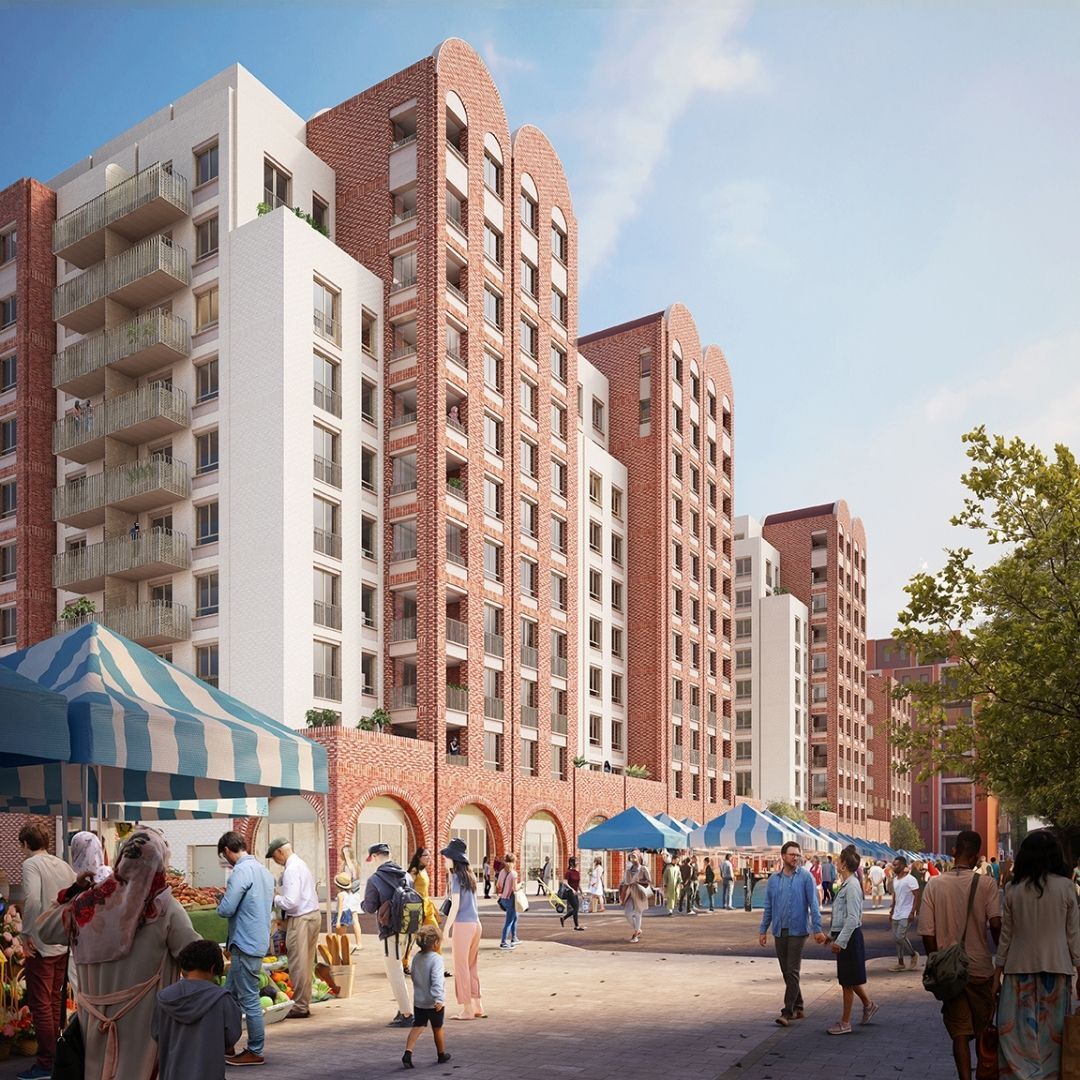Get updates from The Developer straight to your inbox Yes, please!
Church Street Regeneration, City of Westminster, for Westminster City Council, with Bell Phillips, Arcadis, Stantec, Max Fordham, Savills, Flint and Camlins

The 3.84ha development site between Edgware Road – the neighbourhood’s primary retail and commercial area – and quieter terraced streets to the north of Marylebone Station, sees the provision of up to 1,200 new homes with 7,000sqm of retail space. The project aims for a 40% increase in publicly accessible open space and will support around 525 retail jobs and around 3,500 construction-related jobs.
Who is on the project team? (designer, consultants, etc)
Architect: Bell Phillips (sites A and B)
Architect: Mæ (site C)
Lead consultant: Arcadis
Project manager: Arcadis
Structural engineer: Stantec
Civil engineer: Stantec
M&E consultant: Max Fordham
Quantity surveyor: Arcadis
Principal designer: Arcadis
Planning consultant: Savills
Interior designer: Flint
Landscape architect: Camlins
Describe the context of this project, its neighbourhood and people.
The Church Street Regeneration scheme, Westminster, is a mixed-use development and one of the largest projects of its type in London. When complete it will see the provision of up to 1,120 new homes (50% of which will be affordable), flexible retail and affordable workspaces, a new library and community hub, new green spaces within an improved public realm, and upgraded infrastructure to support the popular and long-established Church Street market. Church Street is a vibrant and diverse area with a powerful sense of community. However, it sits within the lowest 20% of the GLA’s wellbeing index, which considers measures including health, economic security, safety, families, accessibility and community. Residents’ health is below the average within Westminster, and there are many elderly or vulnerable residents who require better services and improved accessibility. The area records the highest levels of deprivation in Westminster, with 82% of households classified in at least one dimension of deprivation compared to a Westminster average of 61%. Church Street runs between Edgware Road – the neighbourhood’s primary retail and commercial area – and quieter terraced streets to the north of Marylebone Station. Church Street market has operated for over a century and remains hugely popular, although is not operating as strongly as it has in the past. The masterplan – informed by extensive engagement with local residents, businesses and market traders - recognises the market’s crucial role as an economic, social and cultural anchor within the neighbourhood, and seeks to ensure its long-term and sustainable future.
Please describe your approach to this future place and its mix of uses. How will it function as a vibrant place?
The regeneration of Church Street represents a densification of the site – carefully balancing new buildings and public space to almost triple the number of homes, thereby increasing the number of affordable homes within the neighbourhood, as well as generating revenue from private homes to support the scheme’s holistic package of economic, environmental and social improvements. The new homes – 50% of which will be affordable - are distributed within three new urban blocks, mediating between the bustle of Edgware Road and the quieter streets of Marylebone. Each block is carefully designed with high-level set-backs to avoid dominating the street, and their barrel-vaulted roofs, arches, glazed brick and pronounced soldier courses are among a number of features that reference nearby historic buildings. Along Church Street, a plinth level houses a new library and retail units, prominently located and creating a backdrop to the cluster of commercial activity. The library incorporates a flexible community space, and opens onto an attractive community garden at the rear. New storage units, parking and welfare facilities support the market – rationalising servicing and minimising disruption to residents and local businesses. Whereas the existing estate was almost devoid of green space, the new scheme incorporates an engaging public realm and an abundance of green space. High quality shared open space is an integral element of the masterplan, with fully accessible green space at the centre of the development providing a stimulating environment for all residents to meet, socialise and play.
What is the environmental impact of the project? How will the carbon use and material impact of the development be mitigated? What is the sustainability strategy?
The central design strategy for Helping Hands is to re-appropriate existing space for developing uses. By nature, the project promotes reusability on a site-wide level, encouraging both material and functional circularity. Existing structures are reused and retrofitted where possible, integrated as part of the scheme to implement areas of backland which may usually be overlooked. The workshop which is developed as a later part of the project reuses an existing brick garage - opening it out to the main pathway and becoming a central hub for both learning and construction. Within its building scope, Helping Hands proposes construction training for residents and site-users. This will support upskilling and promote future labour, but will also limit the ‘delivery footprint’ by encouraging local, small-scale development. The project’s emphasis on green space promotes biodiversity uptake and the creation of on-site food production – decreasing the masterplan’s food-related carbon footprint. Where new builds are proposed, both timber frame construction and cladding are used as their main material component, allowing for an overall lower embodied carbon impact to the environment. The design of each of the homes inclusive of footprint are curated in a way in which provides optimum space for users, building smaller yet more crafted spaces for its inhabitants. The roof is designed to optimise solar power as a renewable energy source for each of the homes, helping to offset the long term carbon footprint of the scheme.
Sign up to our newsletter
Get updates from The Developer straight to your inbox
Thanks to our organisation members
© Festival of Place - Tweak Ltd., 124 City Road, London, EC1V 2NX. Tel: 020 3326 7238